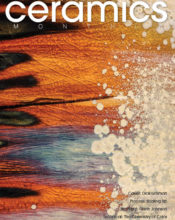
My latest article, in Ceramics Monthly September 2016, explains the science behind colour.

I am really interested in why things are coloured. When white light falls on certain objects, they absorb some colours of light and what we see are the remaining colours of light reflected from the object. Some objects, like trees and grass, use light as energy in photosynthesis and absorb red and blue light, causing them to appear green (the three primary colours which make up white light are red, blue and green). Other objects such as coloured gemstones and glazes have transition metal atoms in them, either as impurities or added intentionally. These absorb some colours of light by promoting some of their electrons to higher-energy orbitals. For example, cobalt silicate in glazes absorbs yellow light. The colour we see is the complementary colour, blue. The colour depends on the type of transition metal and the shape of the electron cloud around it, which can be different in a gemstone from in a glaze, for example, chromium impurities give a red colour in rubies but usually give a green colour in glazes. This is because the surrounding atoms in the ruby crystal are forced closer to the chromium atom than in a glaze.
Click on the link to read the full article: Bloomfield_CMSept16

